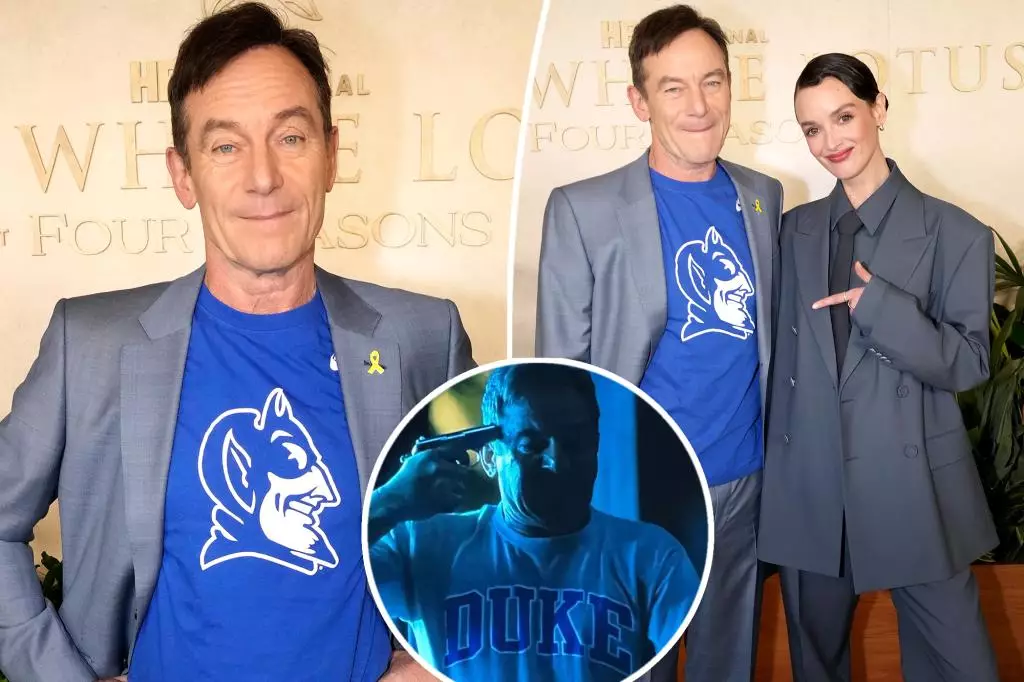In an age where the lines between art and brand identity are increasingly blurred, Jason Isaacs recently demonstrated a remarkable act of defiance at the finale of HBO’s hit series “The White Lotus.” This event, held at the Four Seasons in Westlake Village, showcased not just high-profile actors but also a moment that crystallizes the ongoing dialogue surrounding artistic expression and institutional branding. Isaacs, who plays the enigmatic Timothy Ratliff, made a bold fashion statement by donning a gray suit paired with a striking blue Duke University T-shirt, an outfit that reflects his character’s somewhat dark yet memorable journey throughout the show. This risky choice starkly contrasts with Duke’s recent disapproval of the way their logo was portrayed in the series, demonstrating Isaacs’ resolve to embrace his character’s identity, irrespective of institutional backlash.
Duke University’s Stance: A Dilemma of Values
The controversy erupted shortly after the airing of an episode that featured Ratliff, in a disturbing scene, contemplating self-harm while sporting Duke’s logo. The university released a statement declaring their discontent, describing the show’s usage of its brand as “troubling” and misaligned with the institution’s values. Frank Tramble, Duke’s VP for communications, articulated their concerns about the unintended endorsement that such portrayals could imply. This raises fundamental questions about the intersection of marketing, art, and representation. Should universities have the power to dictate how their images are used in popular culture, especially when the fictional narrative is complex and not explicitly promoting the institution? Duke’s response—while justifiable from a protective standpoint—also points to a growing trend of brands taking a defensive stance against artistic interpretations that might not flatter their image.
The Power of Memes: Modern Cultural Currency
In today’s digital landscape, memes operate as a powerful form of expression and communication, providing layers of meaning that can both support and deride cultural icons. The image of Isaacs’ character in Duke apparel has transformed into a viral sensation following Duke’s unexpected NCAA Final Four defeat, showcasing how popularity can morph into a form of critique. Here, Isaacs appears to be leveraging this cultural moment to poke fun at the notion of brand sanctity, making a statement that art should evolve freely without the constraints of institutional oversight. His fashion choice operates as a challenge to the relationship between artists and the brands they depict, urging viewers to explore the dialogue embedded within these visual cues.
Fashion as a Narrative Tool
The choices made by other cast members on the red carpet echo this ongoing conversation about personal expression versus branding. Patrick Schwarzenegger’s white pinstripe suit and Charlotte Le Bon’s powerful attire in a full Gucci suit illustrate the varying nuances of character representation and the theatricality inherent within Hollywood. Fashion is not merely a superficial aspect of these appearances; it serves a narrative purpose, revealing how actors embody their roles even beyond the screen. The juxtaposition of Isaacs’ bold statement against the backdrop of institutional pushback highlights the potential for misinterpretation in a world that thrives on visual cues.
Thus, the events surrounding the finale of “The White Lotus” not only celebrate artistic creativity but also warrant a larger discussion about the implications of branding in contemporary storytelling. As Jason Isaacs flaunts his character’s pride, he invites us to reconsider the real value of artistic expression in relation to institutional expectations, leaving us with a fresh perspective on the relationship between human creativity and the rigid frameworks often imposed by authority.

